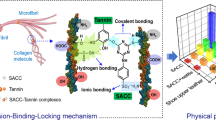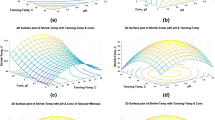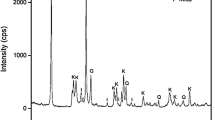Abstract
Click chemistry approaches are tailored to generate molecular building blocks quickly and reliably by joining small units together selectively and covalently, stably and irreversibly. The vegetable tannins such as hydrolyzable and condensed tannins are capable to produce rather stable radicals or inhibit the progress of radicals and are prone to oxidations such as photo and auto-oxidation, and their anti-oxidant nature is well known. A lot remains to be done to understand the extent of the variation of leather stability, color variation (lightening and darkening reaction of leather), and poor resistance to water uptake for prolonged periods. In the present study, we have reported click chemistry approaches to accelerated vegetable tanning processes based on periodates catalyzed formation of oxidized hydrolysable and condensed tannins for high exhaustion with improved properties. The distribution of oxidized vegetable tannin, the thermal stability such as shrinkage temperature (T s) and denaturation temperature (T d), resistance to collagenolytic activities, and organoleptic properties of tanned leather as well as the evaluations of eco-friendly characteristics were investigated. Scanning electron microscopic analysis indicates the cross section of tightness of the leather. Differential scanning calorimetric analysis shows that the T d of leather is more than that of vegetable tanned or equal to aldehyde tanned one. The leathers exhibited fullness, softness, good color, and general appearance when compared to non-oxidized vegetable tannin. The developed process benefits from significant reduction in total solids and better biodegradability in the effluent, compared to non-oxidized vegetable tannins.




Similar content being viewed by others
References
Binder WH, Sachsenhofer R (2007) Click chemistry in polymer and materials science. Macromol Rapid Commun 28:15–54
Bittner S (2006) When quinines meet amino acids: chemical, physical and biological consequences. Amino Acids 30:205–222
Canals Y, Morera JM, Combalia F, Bartoli E, Borras E (2011) Determination of the tanning degree of vegetable-tanned leather by Infrared spectroscopy (FTIR). JALCA 106:264–271
Chen Y, Hagerman AE (2004) Quantitative examination of oxidized polyphenol-protein complexes. J Agric Food Chem 52:6067
Covington AD (1997) Modern tanning chemistry. Chem Soc Rev 26:111–126
Covington AD, Evans CS, Lilley TH, Song L (2005a) Collagen and polyphenols: new relationships and new outcomes. Part 1. Flavonoid reactions for new tanning processes. JALCA 100:325–335
Covington AD, Evans CS, Lilley TH, Suparno O (2005b) Collagen and polyphenols: new relationships and new outcomes, Part 2, phenolic reactions for simultaneous tanning and coloring. JALCA 100:336–343
Gade JN, Fellman JH, Peter BJ (1991) The stabilization of fibrillar collagen matrices with 3,4-dihydroxyphenylalanine. J Biomed Mater Res 25:799–811
George B, Pizzi A, Simon C, Triboulot MC (2004) Leather light stability/tannins antioxidant characteristics for leather made with vegetable tannins/MUF resins. JALCA 99:1–11
Harlan JW, Feairheller SH (1977) Chemistry of the crosslinking of collagen during tanning. Adv Exp Med Biol 86A:425–440
Hartzfeld PW, Forkner R, Hunter MD, Hagerman AE (2002) Determination of hydrolysable tannins (gallotannins and ellagitannins) after reaction with potassium iodate. J Agric Food Chem 50:1785–1790
Heidemann E (2000) Leather. Ullmann’s encyclopedia of industrial chemistry. Wiley, Weinheim
Krishnamoorthy G, Madhan B, Sadulla S, Raghava Rao J, Mathulatha W (2008) Stabilization of collagen by plant polyphenolics Acacia mollissima and Terminalia chebula. J Appl Polym Sci 108:199–205
Krishnamoorthy G, Sehgal PK. Mandal AB, Sadulla S (2011) Protective effect of Withania somnifera and Cardiospermum halicacabum extracts against collagenolytic degradation of collagen. Appli Biochem Biotechnol Part A: Enzym Eng Biotechnol 165:1075–1091
Krishnamoorthy G, Sehgal PK, Mandal AB, Sadulla S (2012) Studies on collagen-tannic acid collagenase ternary system: inhibition of collagenase against collagenolytic degradation of extracellular matrix component of collagen. J Enzym Inhib Med Chem 27:451–457
Liao XP, Du X, Tang W, Shi B (2004) Equilibrium and kinetics of vegetable tanning process. JALCA 99:191–196
Madhan B, Krishnamoorthy G, Raghava Rao J, Nair BU (2007) Role of green tea polyphenols in the inhibition of collagenolytic activity by collagenase. Int J Biol Macromol 41:16–22
Mazumder D, Biswas S, Bandyopadhyay P (2006) Study on leaching of pollutants from vegetable tanning residue. J Environ Sci Eng 48:225–230
Moses JE, Moorhouse AD (2007) The growing applications of click chemistry. Chem Soc Rev 36:1249–1262
Ozgunay H (2008) Light fastness properties of leathers tanned with various vegetable tannins. JALCA 103:345–351
Pizzi A, Simon C, George B, Perrin D, Triboulot MC (2004) Tannin antioxidant characteristics in leather versus leather light stability: models. J Appl Polym Sci 91:1030–1040
Poncet-Legrand C, Cabane B, Bautista-Ortin AB, Carrillo S, Fulcrand H, Perez J, Vernhet A (2010) Tannin oxidation: intra-versus intermollelcular reactions. Biomacromolecules 11:2376–2386
Saito K, Sun G, Nishide H (2007) Green synthesis of soluble polyphenol; oxidative polymerization of phenol in water. Green Chem Lett Rev 1:47–51
Schofield P, Mbugua DM, Pell AN (2001) Analysis of condensed tannins: a review. Animal Feed Sci Technol 91:21–40
Simon C, Pizzi A (2003) Light fast and high shrinkage temperature leather produced using vegetable. JALCA 98:83–96
Tariq SR, Shah MH, Shaheen N (2009) Comparative statistical analysis of chrome and vegetable tanning effluents and their effects on related soil. J Hazard Mater 169:285–290
Yoshida T, Hatano T, Ito H (2000) Chemistry and function of vegetable polyphenols with high molecular weights. BioFactors 13:121–125
Author information
Authors and Affiliations
Corresponding authors
Additional information
Responsible editor: Philippe Garrigues
Rights and permissions
About this article
Cite this article
Krishnamoorthy, G., Ramamurthy, G., Sadulla, S. et al. Click chemistry approach to conventional vegetable tanning process: accelerated method with improved organoleptic properties. Environ Sci Pollut Res 21, 10678–10685 (2014). https://doi.org/10.1007/s11356-014-3069-3
Received:
Accepted:
Published:
Issue Date:
DOI: https://doi.org/10.1007/s11356-014-3069-3




